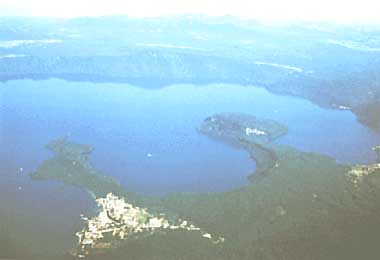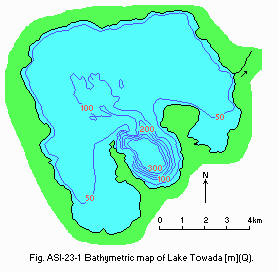TOWADA-KO (LAKE TOWADA)
An aerial view of the whole lake

Photo: Aomori Prefectural Government
A. LOCATION
- Akita and Aomori Prefectures, Japan.
- 40:28N, 140:53E; 401 m above sea level.
B. DESCRIPTION
Lake Towada is located in Towada-Hachimantai National Park, which occupies a mountainous area on the border between the two Prefectures, Aomori and Akita. It is known as a typical double caldera of volcanic origin, encircled by sommas about 800 m in altitude. The lake water drains from the northeastern part via Oirase River and eventually to the Pacific Ocean. A small town on the southern shore, Yasumiya, is the tourist centre with Towada Science Museum, hotels and shops.
Though L. Towada remains oligotrophic, the local governments are trying to maintain and increase fish production by the artificial hatching and breeding of fry since the first success with sockeye salmon (Oncorhynchus nerka) in 1903. The salmon has recently been decreasing, while Japanese smelt (Hypomesus nipponensis) and common brackish gobby (Acanthogobius flavimanus) are increasing since 1984 (Q).
C. PHYSICAL DIMENSIONS (1, 2)
| Surface area [km2] | 59 |
| Volume [km3] | 4.2 |
| Maximum depth [m] | 334 |
| Mean depth [m] | 71.0 |
| Water level | Regulated |
| Normal range of annual water |
| - level fluctuation [m] | 1.7 |
| Length of shoreline [km] | 27.5 |
| Residence time [yr] | 8.5 |
| Catchment area [km2] | 129 |
D. PHYSIOGRAPHIC FEATURES
D1 GEOGRAPHICAL (Q)
- Bathymetric map: Fig. ASI-23-01.
- Names of main islands: None.
- Number of outflowing rivers and channels (name): 1 (Oirase R.).

Fig. ASI-23-01
Bathymetric map [m](Q).
D2 CLIMATIC
- Climatic data at Yasumiya, 1977-1981 (9)
| Jan | Feb | Mar | Apr | May | Jun | Jul | Aug | Sep | Oct | Nov | Dec | Ann. |
| Mean temp. [deg C] | -4.6 | -4.7 | -0.9 | 4.1 | 10.0 | 15.5 | 19.6 | 19.6 | 15.6 | 10.4 | 4.3 | -0.2 | 7.4 |
| Precipitation [mm] | 81 | 81 | 127 | 126 | 120 | 169 | 176 | 264 | 152 | 152 | 137 | 140 | 1,725 |
- Number of hours of bright sunshine: 1,691 hr yr-1 (9).
- Water temperature [deg C](3, 10)
| 1985 |
| Depth [m] | Jan | Feb | Mar | Apr | May | Jun | Jul | Aug | Sep | Oct | Nov | Dec |
| 0.5 | - | - | - | 2.8 | 4.0 | 7.9 | 17.5 | 23.5 | 21.0 | 14.5 | 11.5 | - |
| 5 | - | - | - | 3.0 | 4.0 | 8.4 | 16.0 | 22.5 | 20.7 | 15.0 | 11.0 | - |
- Freezing period: December-March.
- Mixing type: Dimictic.
E. LAKE WATER QUALITY
E1 TRANSPARENCY [m](3, 10)
| Station A, 1985 |
| Depth [m] | Jan | Feb | Mar | Apr | May | Jun | Jul | Aug | Sep | Oct | Nov | Dec |
| - | - | - | 8 | 11 | 11 | 12.5 | 16.5 | 11 | 14 | 14 | - |
E2 pH (3, 10)
| Station A, 1985 |
| Depth [m] | Jan | Feb | Mar | Apr | May | Jun | Jul | Aug | Sep | Oct | Nov | Dec |
| 0.5 | - | - | - | 7.8 | 7.8 | 7.7 | 7.9 | 8.1 | 8.1 | 8.0 | 7.9 | - |
| 5 | - | - | - | 7.8 | 7.8 | 7.7 | 8.0 | 8.2 | 8.1 | 8.0 | 7.9 | - |
E3 SS [mg l-1](3, 10)
| Station A, 1985 |
| Depth [m] | Jan | Feb | Mar | Apr | May | Jun | Jul | Aug | Sep | Oct | Nov | Dec |
| 0.5 | - | - | - | <1 | <1 | <1 | <1 | <1 | <1 | <1 | <1 | - |
| 5 | - | - | - | <1 | <1 | <1 | <1 | <1 | <1 | <1 | <1 | - |
E4 DO [mg l-1](3, 10)
| Station A, 1985 |
| Depth [m] | Jan | Feb | Mar | Apr | May | Jun | Jul | Aug | Sep | Oct | Nov | Dec |
| 0.5 | - | - | - | 13 | 12 | 12 | 9.2 | 7.9 | 8.7 | 9.0 | 10 | - |
| 5 | - | - | - | 13 | 13 | 12 | 9.7 | 8.2 | 8.7 | 9.2 | 10 | - |
E5 COD [mg l-1](3, 10)
Determined by KMnO4 method.
| Station A, 1985 |
| Depth [m] | Jan | Feb | Mar | Apr | May | Jun | Jul | Aug | Sep | Oct | Nov | Dec |
| 0.5 | - | - | - | <0.5 | 1.0 | <0.5 | 0.9 | 0.8 | <0.5 | 1.1 | 0.8 | - |
| 5 | - | - | - | 0.7 | 1.0 | 0.5 | 1.0 | 1.0 | 0.5 | 1.2 | 1.1 | - |
E6 CHLOROPHYLL CONCENTRATION [micro g l-1](3, 10)
| Station A, 1985 |
| Depth [m] | Jan | Feb | Mar | Apr | May | Jun | Jul | Aug | Sep | Oct | Nov | Dec |
| 0.5 | - | - | - | 1.1 | 0.6 | 0.5 | 0.3 | 0.1 | <0.5 | 0.4 | 0.5 | - |
E7 NITROGEN CONCENTRATION (3, 10)
| Station A, 1985 |
| Depth [m] | Jan | Feb | Mar | Apr | May | Jun | Jul | Aug | Sep | Oct | Nov | Dec |
| 0.5 | - | - | - | <0.05 | <0.05 | <0.05 | 0.10 | 0.06 | 0.05 | 0.05 | <0.05 | - |
E8 PHOSPHORUS CONCENTRATION (3, 5)
| Station A, 1985 |
| Depth [m] | Jan | Feb | Mar | Apr | May | Jun | Jul | Aug | Sep | Oct | Nov | Dec |
| 0.5 | - | - | - | .003 | .004 | <.003 | .005 | .004 | <.003 | .003 | <.003 | - |
F. BIOLOGICAL FEATURES
F1 FLORA
- Emerged macrophytes: Phragmites communis (10).
- Submerged macrophytes (10)
Potamogeton maackianus, P. pectinatus, P. heterophyllus, P. compressus, Myriophyllum spicatum.
- Phytoplankton (4, 10)
Spring: Fragilaria, Synedra, Mougeotia, Asterionella. Summer: Fragilaria, Synedra, Mougeotia. Autumn: Asterionella.
F2 FAUNA
- Zooplankton (4, 10)
Keratella quadrata, Daphnia longispina, Acanthodiaptomas pacificus, Filinia quadrata, Polyarthra trigla.
- Benthos (4)
Tubificinae, chironomid larva, Pisidium kawamurai (in 1985, larvae of Ephemera and those of two species of Phyganoidea were also collected).
- Fish (4, 10)
Oncorhynchus nerka, O. masou masou, Hypomesus nipponensis, Cyprinus carpio, Carassius, Gasterosteus aculeatus aculeatus, Chaenogobius urotaenia.
F4 BIOMASS (4)
- Plankton biomass (precipitated)[mg m-3]
| Average of 10 stations, summer |
| 1981 | 1982 | 1983 | 1984 | 1985 |
| 5.64 | 1.81 | 2.10 | 1.26 | 0.56 |
F5 FISHERY PRODUCTS
- Annual fish catch [metric tons]
1985: 88.2.
- Fishery products other than fish [kg yr-1]
1985: 450.
F7 NOTES ON THE REMARKABLE CHANGES OF BIOTA IN THE LAKE IN RECENT YEARS (4)
The amount of zooplankton was a bit smaller in 1985 than the average for past
several years. Hypomesus nipponensis, Gasterosteus aculeatus and
Acanthogobius flavimanus are increasing since 1984, while Oncorhynchus nerka
tends to decrease.
G. SOCIO-ECONOMIC CONDITIONS
G1 LAND USE IN THE CATCHMENT AREA (10)
Natural landscape nearly 100%.
- Main types of woody vegetation
Deciduous broadleaf forest (Fagus crenata dominant, with Pterocarya rhoifolia, etc.).
G2 INDUSTRIES IN THE CATCHMENT AREA AND THE LAKE (5, 6)
| 1984 |
| Gross product per year [yen] (250 yen=US$1) | No. of persons engaged | No. of establishments | Main products or industries |
| Primary industry |
| - Fisheries | 45,859,000 | N.A. | N.A. |
| Tertiary industry | N.A. | 408 | 43 | Hotel business |
* Number of domestic animals in the catchment area: Cattle 2.
G3 POPULATION IN THE CATCHMENT AREA
Number of permanent residents 263; population density 2.0 [km-2].
H. LAKE UTILIZATION
H1 LAKE UTILIZATION (8)
Tourism and recreation (swimming, yachting, sport-fishing)(no. of visitors in
1985: 1,590,000) and fisheries.
I. DETERIORATION OF LAKE ENVIRONMENTS AND HAZARDS
I2 TOXIC CONTAMINATION (3)
- Present status: None.
- Main contaminants and their concentrations
| In water, 1986 |
| [ppm] |
| Name of contaminant | T-Hg | Cd | Cr (VI) | CN | Pb | As | PCB | Pesticide (org-P)
|
| Concentration | <.0005 | <.005 | <.02 | N.D. | <.005 | <.02 | N.D. | N.D. |
I3 EUTROPHICATION
- Nuisance caused by eutrophication: None.
I4 ACIDIFlCATION
J. WASTEWATER TREATMENTS (Q)
J1 GENERATION OF POLLUTANTS IN THE CATCHMENT AREA
b) No sources of significant pollution.
J3 SANITARY FACILITIES AND SEWERAGE
- Percentage of rural population with adequate sanitary facilities (on-site
treatment systems): 100%.
M. LEGISLATIVE AND INSTITUTIONAL MEASURES FOR UPGRADING LAKE ENVIRONMENTS (Q)
M1 NATIONAL AND LOCAL LAWS CONCERNED
- Names of the laws (the year of legislation)
- For national laws see "Biwa-ko"
- Akita Prefectural Pollution Control Ordinance (1972)
- Aomori Prefectural Pollution Control Ordinance (1972)
- Responsible authorities
- Akita Prefectural Government
- Aomori Prefectural Government
M3 RESEARCH INSTITUTES ENGAGED IN THE LAKE ENVIRONMENT STUDIES
- Centre for Environmental Technics, Akita Prefecture, Akita (established in 1970)
- Inland Water Fishery Station, Akita Prefecture, Hachirogata (established in 1957)
- Environmental Pollution Control Centre of Aomori Prefecture
N. SOURCES OF DATA
- Questionnaire filled by the Prefectural Governments of Akita and Aomori.
- Tsuda, M. (ed.)(1975) Diagnosis of Japanese Lakes; the Present Conditions of Eutrophication. Kyoritsu Shuppan, Tokyo (in Japanese).
- Ministry of Construction (1978) Report of River Surveys. Tokyo (in Japanese).
- Data supplied by Akita Prefectural Government.
- Lake Towada Hatchery Station: Report on Resource Conservation in Lake Towada (in Japanese).
- Data supplied by the town office of Kosaka-cho.
- Enterprise Statistics for 1986.
- Data supplied by the town office of Kosaka-cho.
- Data supplied by the Tourism Section, Akita Prefectural Government.
- Takahashi, K. (ed.)(1983) Meteorological Data of Japan. 157 pp. Tokyo keizaishinpo-sha, Tokyo (in Japanese).
- Data supplied by Aomori Prefectural Government.




